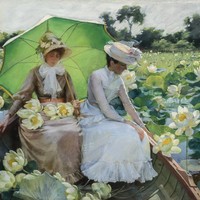Lotus Lilies
Item
-
Name
-
Lotus Lilies
-
Summary
-
In Charles Courtney Curran’s Lotus Lilies, two women sit together in a rowboat surrounded by lotus lilies that cover most of the visible surface of a lake, its low-lying shore visible in the distance. The sky is bright with the heat of a summer day, but the women are protected from the glare by hats, diaphanous veils, and a large green parasol. The woman on the right leans out of its shade to pluck lotus blossoms, which are gathered in the lap of her companion sheltering under the parasol aglow with transmitted light.
The foreshortened perspective on the boat, cut off at the lower edge of the picture, positions the observer vicariously as a member of the boating party. The women’s comfortable disregard of our gaze suggests the ease of familiarity. Indeed, Curran’s models were his new bride, Grace Winthrop Wickham, on the right, and her cousin, Charlotte "Lottie" Ada Taylor, on the left. The setting is Old Woman Creek, an estuary of Lake Erie in Ohio, where the Wickham family owned several summer cottages. The theme of lilies likely held special significance, for Grace carried a bouquet of water lilies at the couple’s wedding ceremony that summer.
At a time of unprecedented economic and industrial growth in the United States, artists increasingly turned to the subject of genteel leisure, as in Irving Ramsey Wiles’s On the Veranda (TF 1999.152) and Frederick Frieseke’s Lilies (TF 1999.55). Here, nestled among the lotuses, the two women are in harmony with the landscape. No sign of labor or exertion intrudes on the tranquil scene; for example, the rowboat lacks oars for propelling it across the water’s surface. Little effort is required by the women to approach the oversize blossoms that rise within easy reach on all sides. The lotus lily form is echoed in the framing of Lottie Taylor’s face by her bonnet and parasol. Evoking a longstanding association between women and flowers, Curran’s image implies a correspondence between the luxuriant pale blooms and the beautiful young women to suggest both sexual purity and virtuous natural fecundity. He also hints at the contrast between traditional confinement of women and the new prospects then opening for them. In contrast to Lottie’s old-fashioned bonnet, passive posture, and modest downward gaze, Grace, sporting a fashionable boater hat (adopted from men’s headgear), breaks out of the protected sphere defined by the parasol as she reaches beyond the confines of the boat.
Although Lotus Lilies predates Curran’s first trip to France in 1889, it demonstrates his awareness of the emerging aesthetic of impressionism. Like many Americans experimenting in the new mode, he tempered bold color and free brushwork with tight academic drawing and a balanced composition. Curran thought enough of Lotus Lilies to bring it with him to Paris, where he exhibited it at the prestigious Salon of 1890. Eminent critic Ernest Hoschedé praised the painting as "the best of modernity." In making contemporary life the subject of his ambitious painting, Curran followed a new trend that elevated everyday experience over historical, literary, and mythological subjects as the theme of high art. (Source: Terra Foundation for American Art)
-
Date
-
1888
-
Dimensions
-
18 × 32 in. (45.7 × 81.3 cm)
-
Provenance
-
The artist
Edwin Lefevre
Robert Skinner, Inc., Bolton, Massachusetts, October 20, 1978, lot 20
Bryan Olifant, New York
Jeffrey R. Brown Fine Arts, North Amherst, Massachusetts, 1979
Daniel J. Terra Collection, Chicago, Illinois, 1980
Terra Foundation for the Arts Collection, Chicago, Illinois, 1999
-
Identifier
-
1999.35
-
Rights
-



